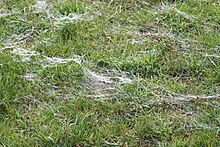Spider flight

When flying spiders , also known as ballooning or airships , spiders can be lifted into the air by the wind and carried over greater distances. In favorable wind conditions, they cover distances of several hundred kilometers in this way. This happens because the spider produces several dozen silk threads in the wind, which are then carried along with the spider. The latest research describes a similar behavior in calm conditions, when the spiders use the electrostatic field in the air.
The spider threads flying in the air in large numbers, especially in late summer, probably led to the name " Indian summer ", as the spider threads are reminiscent of gray hair.
description
Mainly young, immature and therefore very light spiders, but also adult specimens of the canopy spiders , start their flight from places that are particularly exposed to wind. They begin to trip as if on tiptoe and then shoot one or a whole bundle of threads into the air from their spinnerets on the abdomen, which expand like a kind of fan. Hanging from this "sail" made of around 50 to 60 extremely light and therefore very airworthy silk threads, the spider can be hoisted at heights of several kilometers and carried away over very great distances. With favorable winds, the animals even get into the jet stream , which can carry them across entire oceans. In this way they had found their way into the rigging of Charles Darwin's Beagle as early as 1832 - a hundred kilometers off the coast of Argentina. However, the chances of survival on such a trip are low.
It is assumed that spiders weighing more than 1 mg on a single thread drink can hardly fly, which is why young animals are mostly observed flying. However, there are significant exceptions. Adult females of the species Stegodyphus dumicola, for example, weighing more than 100 mg and 14 mm tall, were observed flying on particularly hot and windless days. For this they produced a triangular sail up to 1 m wide, consisting of a web of several hundred silk threads, which they carried away in the resulting thermals. In 2012 and 2015, a million-fold spider flight was observed in Australia, which made the ground look like snow-covered after landing. More recent findings even point to spider flight completely without wind, using electrostatic atmospheric fields.
Reach and height
While most spider flights end after a few meters, in rare cases the spiders are carried away by updrafts in such a way that they can even reach heights of a few kilometers. Under certain circumstances, they can cover several hundred kilometers, which explains, among other things, their sightings on remote ocean islands or in the rigging of ships. Under specific laboratory conditions, some spiders can go without food for up to 25 days and longer. This ability is an important evolutionary advantage for the development of new habitats.
See also
Web links
- Video of a spider flight
- Spiders on a plane
- Spiders fly around the world with their own balloons
- Research Current (Deutschlandfunk)
Individual evidence
- ↑ a b Moonsung Cho, Peter Neubauer, Christoph Fahrenson, Ingo Rechenberg: An observational study of ballooning in large spiders: Nanoscale multi fibers enable large spiders' soaring flight . In: PLOS Biology . tape 16 , no. 6 , June 14, 2018, ISSN 1545-7885 , p. e2004405 , doi : 10.1371 / journal.pbio.2004405 ( plos.org [accessed July 22, 2018]).
- ^ Charles Darwin: Journal of Researches Into the Geology and Natural History of the Varoius Countries Visited by HMS Beagle. Under the Command of Captain Fitzroy from 1832 to 1836. Henry Colburn, London 1840, chap. IX, p. 187. limited preview on Google Books
- ↑ Jutta M. Schneider, Jörg Roos, Yael Lubin, Johannes R. Henschel: Dispersal of Stegodyphus dumicola (Araneae, Eresidae): they do balloon after all! In: Journal of Arachnology . tape 29 , no. 1 , April 2001, ISSN 0161-8202 , p. 114-116 , doi : 10.1636 / 0161-8202 (2001) 029 [0114: dosdae] 2.0.co; 2 .
- ↑ Millions of Spiders Rain Down on Australia — Why? May 18, 2015 ( nationalgeographic.com [accessed July 16, 2018]).
- ↑ Erica L. Morley, Daniel Robert: Electric Fields Elicit Ballooning in Spiders . In: Current Biology . tape 28 , no. July 14 , 2018, ISSN 0960-9822 , doi : 10.1016 / j.cub.2018.05.057 ( cell.com [accessed July 17, 2018]).
- ↑ Spiders fly “electrically” - Wissenschaft.de . In: Wissenschaft.de . July 5, 2018 ( Wissenschaft.de [accessed July 17, 2018]).
- ↑ Tina Baier: Spiders on a flight . In: sueddeutsche.de . July 6, 2018, ISSN 0174-4917 ( sueddeutsche.de [accessed July 17, 2018]).
- ↑ How Spiders 'Fly' Hundreds of Miles . In: Live Science . ( livescience.com [accessed July 20, 2018]).
- ↑ G. Hormiga: Orsonwelles, a new genus of giant linyphiid spiders (Araneae) from the Hawaiian Islands . In: Invertebrate Systematics . tape 16 , no. 3 , 2002, ISSN 1447-2600 , p. 369–448 , doi : 10.1071 / it01026 ( csiro.au [accessed July 22, 2018]).
- ↑ Stefan Heimer: Wonderful world of spiders . 1st edition, 1st – 20th Tsd. Urania-Verl, Leipzig 1988, ISBN 3-332-00210-4 .
- ^ Carlos E. Valerio: A Unique Case of Mutualism . In: The American Naturalist . tape 109 , no. 966 , April 1975, p. 235-238 , JSTOR : 2459657 .
- ^ SW Bilsing: Quantitative Studies in the Food of Spiders . May 1920, ISSN 0030-0950 ( osu.edu [accessed July 22, 2018]).
literature
- Dean, DA & Sterling, WL (1985): Size of ballooning spiders at two locations in eastern Texas. Journal of Arachnology 13 : 111-120. PDF
- Heimer, S. (1988): Wonderful world of spiders. Urania-Verlag Leipzig, ISBN 3-332-00210-4 .


